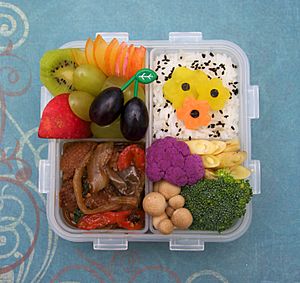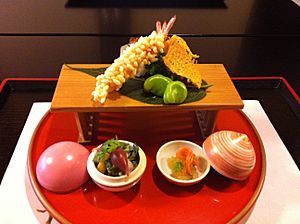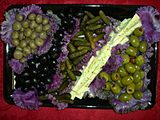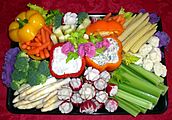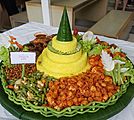Food presentation facts for kids
Food presentation is all about making food look amazing! It's the art of changing, arranging, or decorating food to make it more appealing to the eye.
Chefs think about how food looks at every step. This includes how they tie meats, how they cut vegetables, or even the type of mold they use for a dish. Food itself can be decorated, like fancy cakes with lots of icing. It can also have edible decorations, sauces drizzled on top, or sprinkles of seeds or powders. Sometimes, food comes with pretty garnishes, which can be edible or just for show.
Historically, showing off food was a way to display wealth and power. These displays often focused on how complex a dish was, rather than just its taste. For example, in ancient Rome, hosts might add precious metals to food to make it look richer. In the Middle Ages, rich people held feasts with food sculptures and even live animals. These banquets were meant to show how cultured and wealthy the host was.
Today, food presentation often shows the chef's creativity. Think of French nouvelle cuisine or Japanese bento boxes. Some styles are simple, while others are very complex. Overall, how food is presented often reflects what society values at that time.
Contents
Plating: Making Food Look Great
Plating is how food is arranged and styled when it's put on a plate. There are a few common ways to do this:
- Classic style: The main food item is at the front, with vegetables or starches behind it.
- Stacked style: Different food items are piled on top of each other.
- Shingled style: The main item leans or overlaps on a bed of vegetables or a side dish.
Food Presentation Through Time
Ancient Rome: Feasts and Fancy Food
Banquets were important social events in ancient Rome. They were usually held in private homes for friends and important guests. Romans paid a lot of attention to their dining rooms, decorating them with murals, mosaics, and sculptures. The main goal of these banquets was entertainment, not just through performances, but also through the food itself.
Meals had three parts: appetizers, the main course, and dessert. They were often brought out with special rituals. Sometimes, at very fancy events, the main course was served with trumpets playing! Foods like wild game (pheasant, boar), certain fish, and wild berries were highly valued. This was because they were exotic and expensive. Some old stories say that Emperor Claudius added crushed pearls to wine and gold flakes to peas just to make them cost more. Other stories tell of live animals being served to show off wealth. For example, some fish were presented alive to show their shiny bodies.
Medieval Europe: Grand Banquets
Rich people in medieval Europe also wanted to entertain and impress with food. Banquets were huge feasts with many different dishes. Social rules meant that the wealthy got beautiful, fancy dishes, while the poor received simpler food, often scraps. These banquets not only entertained guests but also showed how rich the host was. Sometimes, the host would hire artists to create amazing sculptures made from food. Popular choices included pies or cakes designed to release live birds when cut open. Also popular were colorful jellies stacked together, dyed with spices and vegetable colors.
Modern Food Presentation
Today, how food looks reflects both personal and shared ideas about beauty. In the past, food was closely linked to wealth. But now, different kinds of food are much more available to everyone. You can find a hamburger at a fancy restaurant and exotic dishes on street corners. So, modern food presentation is more about creativity and new ideas than showing off wealth.
France: Simple and Stylish Cuisine
Nouvelle cuisine is a style of French cooking that avoids overly showy food. Instead, it focuses on simple presentation and really good ingredients. Unlike chefs in the past who just followed orders, this style lets the chef be an inventor and artist. Nouvelle cuisine emphasizes minimalism, meaning fewer courses and simple plating. Chefs became very creative in making new recipes and plating them beautifully.
Japan: Art in Every Meal
Bento Boxes: Meals in a Box
A bento box is a Japanese meal that usually has rice, meat or fish, and vegetables. It's served in a portable box. In Japan and the United States, people pay a lot of attention to how the food is arranged in the box. There have even been contests to see who can make the most creative bento boxes! This allows everyday people to be creative. Sometimes, bento boxes are used to make sculptural designs, like rice shaped to look like animals. These special bento boxes are called Kyaraben or charaben. This is short for "character bento." Kyaraben are often made by mothers to encourage their children to eat healthy foods and to show their love.
Kaiseki: A Multi-Course Masterpiece
Kaiseki is a fancy Japanese multi-course dinner. It usually has 7 to 14 courses. You might find it at traditional Japanese inns called ryokan or in small restaurants. A big part of kaiseki is the detailed preparation and beautiful presentation of these meals. This helps to bring out the natural flavors of fresh, local ingredients. Meals are often decorated with edible leaves and flowers to show the season. They are also arranged to look like natural plants and animals.
Kaiseki dinners usually include an appetizer, sliced raw fish (sashimi), a simmered dish, a grilled dish, and a steamed dish. Other dishes might be added or left out depending on the chef. Here are some common courses:
- Sakizuke: An appetizer.
- Hassun: A course with sushi and several small side dishes.
- Mukōzuke: Sliced, seasonal sashimi.
- Takiawase: Simmered vegetables with meat, fish, or tofu.
- Futamono: A "lidded dish," usually a soup.
- Yakimono: A grilled dish, often fish.
- Su-zakana: A small dish of vegetables in vinegar, used to clean your palate.
- Hiyashi-bachi: Chilled, lightly cooked vegetables (only in summer).
- Naka-choko: A light, sour soup to clean your palate.
- Shiizakana: A bigger dish, like a hot pot.
- Gohan: A rice dish made with seasonal ingredients.
- Kō no mono: Seasonal pickled vegetables.
- Tome-wan: A miso-based or vegetable soup served with rice.
- Mizumono: A seasonal dessert.
Science Behind Food Looks
Modern science helps us understand why people react to food presentation in certain ways. A study found that people respond differently to things like color, how things are arranged on the plate, and how much empty space there is. They discovered that people liked plates best when they had four different colors, three different parts, some empty space, and a casual, less organized look.
This research is important because understanding how food presentation affects eating can help with health and nutrition. For example, another study showed that people who ate at tables that weren't cleaned (meaning all uneaten food was left there) ate less. This is probably because seeing the leftovers made them less likely to take more food. This idea could be useful in fighting issues like obesity.
Another example of science in food aesthetics is the development of "molecular food" in Spain. This style uses scientific ideas to explore the essence of food. Molecular science can break down carbohydrates and proteins to find out what creates specific tastes. For instance, modern science makes it possible to freeze ice cream using liquid nitrogen or create wine using sugars. This leads to new dishes that are both efficient and visually interesting.
Trends and Fads in Food
Just like fashion, food presentation has its own trends and fads. For example, "unicorn food" became popular in 2017. This style uses a rainbow color palette to decorate food. The soft, pastel colors are meant to look like the mythical unicorn.
Images for kids


